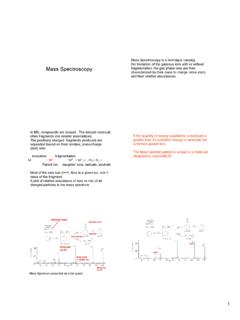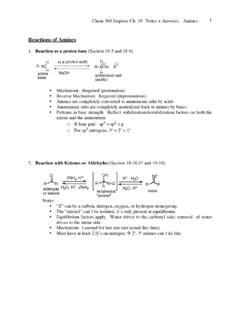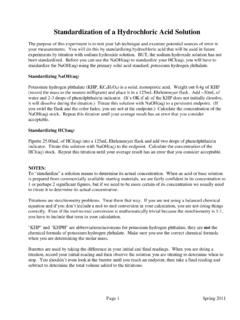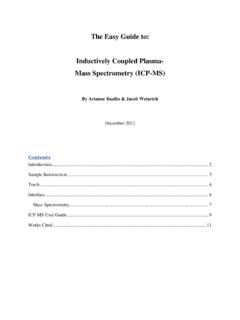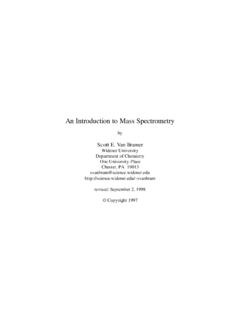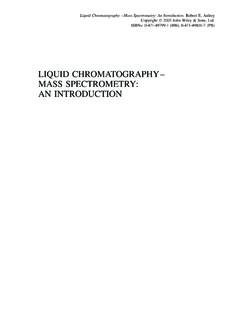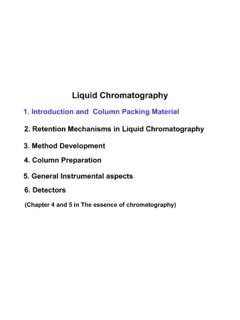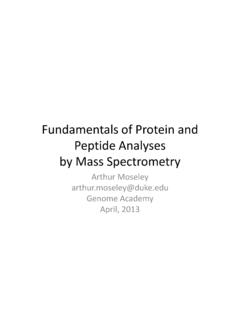Transcription of Gas Chromatograph Gas Chromatography
1 Gas ChromatographyChromatography: Separate analytes in a mixturewith a resolution in the shortest amount oftime and detection of separated Chromatograph123456= Gas supplies usually have traps to remove anywater, oxygen, hydrocarbons or other contaminants from compressed gases Instruments can have multiple injectors,detectors or columns Injectors and detectors temperatures controlled The GC oven has a large fan and a vent door forrapid cooling/heating. Data collection /and integration system The analyte (GC) necessarily in gas between the mobile phase (carriergas) and the liquid stationary phase(predominant) inside capillary column or onparticles inside a packed column Some packed-column GC uses non-coatedsolid stationary phases; gas-solid adsorptionchromatographyAchieve separation by using suitable; columns with properstationary phase, diameter ofcolumn,stationary phase loading, , and columnlength. injection modes to optimize the of loading andseparation of the sample mixture temperature (or pressure) programs for thecolumn detector that is suitable for theanalyte(s)of interestEarly practice of gas Chromatography was done withpacked columns.
2 Such columns are still used forpreparative Chromatography as they can handle largeramounts of (analytical) is practiced with capillarycolumns, which are open tubular Phase: Bonded; poly(50% n-octyl/50%methylsiloxane)Temp. Limits:-60 C to 280 C (isothermal orprogrammed);< mm Tubular ColumnsWCOT, is coated as a specifically is the primary type of capillaryGC column for quantitative analysis:Higher resolution and shorter analysis time and allowsgreater ability to discriminate between is small,is of less concern for analyticalpurposes as long as sufficient analyte is available fordetection; pg/mL (ppt) to g/mL (ppb). Column constructed of fused silica tubing Polyamide coating gives it strength liquid stationaryphases coated or chemicallybonded to the inner wall of capillary Column , length 30-60mStationary phases substitutedpolysiloxanesOHSiOSiOSiOSiOSi OHRRRRRRRRRRC olumn:Characterized byStationaryphase(mobile phase, LC)materials inert particle loadingwhichis proportional to film thicknessdfand thecolumn range of operation (GC); dependent,Bonded thermally phase-carrier gas (GC), usually an inert gas,primarily pushes the material through the column.
3 InLC; is a solvent, should be compatible with theanalytes and influences the equilibration processin partitioning column suitability for analysis is determined in LC and, in GC:Use with similar polar characteristics as theanalytes to effect a analytes require polar stationary phases to beretained in analytes require less/non-polar generally are a mixture of polar and non-polar components compromise vs. resolutionDiameter vs. resolutionStationary phase thickness vs. resolutionThick films: increases column bleedingSample capacity v. resolutionSample capacity:the amount of sample that can beinjected onto a column without overloading. Oftenexpressed as grams of sample per gram of is defined as the point at which thesample mass injected makes the column efficiencyN, decrease by 10% from its normal value;sometimes called sample columnsIncreased length leads to longer separation times;band broadening problems arise if too phase thickness and column diameterincreases leads to increased sample capacity andcan provide increased resolution; tradeoffs-longeranalysis time and more column stationary phases bleed more-contaminateMS detection ColumnsThey have greater sample capacity vs.
4 Open tubularcolumns but generates broader peaks, longer retentiontimes and lower for preparative work. Capillary Columns: Higher R Smaller H; high N fast Greater sensitivity analytical Smaller samplecapacity Higher cost/column Columns fragile Packed Columns Low R Larger R, low N Slow Greater samplecapacity Lower cost More rugged preparativeCapillary vs. Packed ColumnsColumn selection GC:Select a stationary phase that would retain( dissolve ) the analytes of phase polarity ~ analyte polarity;(like dissolves like).Selectivity to individual analytes determinesthe quality of separation (ability to discern thecomponents) measured in terms of relative B Order of elution(GC):Lesser retained analytes elute similar molecular characteristics, morevolatile analytes ( , high vapor pressure) elutesearlier; molecular masses elutes polarity, molecular mass , pressureof analytesin concert withthe polarity of thephase(s)to determine the order of Forces (attractive):IMFsdetermine the retention times.
5 GC both phases. This is a forces (weakest but always present)sp nonpolar;Polydimethylsiloxanesp strongly polarPolyethylene glycolsp-nonpolarsp strongly polarGiven similar molecular characteristics,more volatile analytes ( , high vaporpressure) elutes earlier; low molecularmasses elutes times changes with the polarity of thestationary phase (GC in particular).Kovat sRetention Index:A logarithmic scale that relates the corrected retentiontimetr , of an analyte to those oflinearalkanesin agiven column ( )Linearalkanes(or any homologous series) elutes inthe increasing order of their molecular sRetention index (RI)bydefinition foranalkane=100n, where n = # C plot oflog(tr )vsRI is value linear homologues.''log( )'' log( )rrta b RIRIabt For an analyte eluting from a column (injected withlinear homologues) between the smaller homologue (n)and N larger homologue (N carbons) has an RI of;'','',,log( ) log()100()log() log()rr nr Nr nttRIInN ntt RI indicates the appearance of a given analyte in thechromatogram in relation to straight chain min'','',,log( ) log()100()log() log() 8 (9 8) nr Nr nttRIInN nttI n like an (hypothetical)alkanewith C stationary phases (GC) give different RIvalues for the same analyte because differentstationary phases will have , in any column order of elution of ahomologous series is the same, elutesfirst.
6 Column (stationary phase) characterization:Based on polarity (operationalIMFs) of the stat. of a stationary phaseis expressed withRIsofprobe/index compoundsin of of probe compounds are measuredon ofinterestandon a totally non polar phase squalene(IMFs-dispersion forces only).Forprobe/indexcompound: (Risp RIsqualene) =McReynold sConstant is compoundMeasures IMF oftypeBenzeneAromatic,olefinic;x 1-butanolElectron attractor;y 2-pentanoneElectronrepeller;z 1-nitropropaneNitro,nitrile;u PyridinePyridine;s McReynold sConstantfor probe compound:= I=(RIsp RIsqualene)McReynold sconstant measures the retention of aprobe in , over that insqualene. It is ameasure of a specific type of polarity of sconstant measures the ability to retardanalytes of specific polar characteristics on thestationary compounds and what they measure: polarity arises from the intermolecular forcescertain chemical moieties are capable of exerting.(hand out)My web pagex y z u s Example;x = Ibenzene=(RIsp RIsqualene)benzeneTotal (effective) retardation polarity of stationaryphase:''.
7 'iIxys Average polarity of ;,11005iRii squaleneIPI Index compoundMeasuresIMFsBenzene, x Aromatic,olefinic1-butanol, y Electron attractor2-pentanone, z Electronrepeller1-nitropropane, u Nitro,nitrilePyridine, s pyridineUtility ofMcReynold sConstants-Examples:Alcohol + ether; very similar boiling points. Columnto elute alcohol before ether?z (ether); y (alcohol).SP2401 or OV210 Ether before alcohol?OV275 or SP2340 Benzene,cyclohexane; boiling points-very time frameOV275 Too longAlmost every column in the short list is technicallyUsable here. Consider elution C8 and C18 columns the stationary phase is a thinfilm of non-polar liquid phase (mono molecular layer)that has been chemically anchored to an inert material(Silica particles).Chemically linked to the silica particles surface byreaction with the polar silanol groups on the stationaryphase surface and renders them less polar or columns have silica particles attached to C8carbon units while C18 is coated with C18 columns are more Columns(HPLC)Modes of Separation:GCIsothermal = constant temperatureGradient = varying temperature temperature too high, causes co-elution poor resolution but faster separation temperature is too low, longer elution times adequate resolution, but a separation that takesvery long compromise temperature or programColumn Temperature The simplest way to alter the separation in GCis to alter the temperature/program in the programming of the carrier gas is lesscommon.
8 By altering the temperature, rate of equilibrationof analytes changes, increases differences in thecapacity factor (k K): they spend more or less time in the stationaryphase the greater the difference in the times betweenanalytes can be fastened and vice Programming: decelerateacceleratei,si,sssi,mi,'imimim nC VV=nKkVKCV lowki too highki i,s,ii mCKC Inert gases (do not react/interact with analytes) Function: sweep the sample through the column protect the column from oxygen exposure(especially) at high temperatures assist with the function of the detectorGC Carrier Gases(mobile phase) Helium (availability in relatively pure state,but availability issues are cropping up) Nitrogen (requires oxygen and water traps) Hydrogen normally used in FID (fuel for the flame) rarely used in as a carrier gas-safety concerns current developmental work has addressed thesafety issuesGC Carrier Gases(mobile phase)HuACBHminBH = A + + CuuTypical plotHuBH = A + + CuuHigh u without compromising packed; smalldpdistribution lowers ABetter particle morphology, low bonded phasedensity (reduce mass transfer delays)reduces slope, CB not much can be donewith column itself,minimize the time ofresidence, optimum uHigh u without compromising H.
9 Samples are injected through a septum: keeps oxygen out of the column provides a seal-carrier gas pressure up atthe head of the column The injector is usually lined with a de-activated glass linerGC InjectionInjection modes On-Column Injection: used widely inpacked-columnGC, less incapillary GC sample-deposited directly on the column Good forthermally unstablecompounds Good forquantitative analysis at lowconcentrations entire sample reaches the detector Smaller injections (Capillary GC) SplitlessInjection: Sample-vaporized in the injector and ALLof the sample is swept onto the column bythe carrier gas Relatively small samples ( 10 L) Sample spends a large amount of time inthe injector Best for trace (1-100 ppm range)concentrations of high boiling pointanalytes in low boiling point solvents extra time in the injector helps volatilize theanalytes. Split Injection: injection is split, with only a fraction of thesample (usually 1%-20%) actually makes itto the column the most common method of injectingsamples onto small diameter, open-tubularcolumns.
10 Even for injections 20 L, only a fraction (which isadjustable) makes it on to the column Not for analytes mixtures with a wide range ofboiling points some may be swept out the split vent before theyare volatilizedModern capillary GCs come with a Split/Splitlessinjectors between modes by changing the split ventgas flow and using a different injection trace analysis, split valve isclosed, most of the sample is introduced on thecolumn. @ flow rate ~1 ml/min. transfer to the columntakes a long time. Thus peak valve opened after 20-120s,sample transfer stops. Yet long transfer can be long,results in increased peak trapping-sample injected with the column ata temperature <20 C the boiling point of solvent .After ~30s (splitlesstime) increase the temperaturefast 20 C above solvent boiling point. Fast transferfrom gas to liquid and again to the gas phasesharpens the elution band.''' 2mcolumn'222f'2sm2 Dqk1+6k11 H= +duu(k1) D24(1rD)kuk GC Capillary Columns: Numerous types of detectors available Requirements: sensitive to the analytes of interest compatible with the column, carrier gas,solvent, etc.
